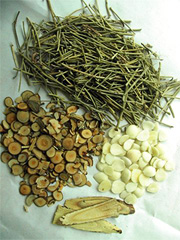Chinese Herb List
This collection covers the origin, properties, chemical constituents, traditional use, pharmacological actions, indications and contraindications of traditional Chinese herbs. Each of the herbs is indexed to assist in searching by either their Pinyin, Latin, common or scientific name as well as by primary function.
Click to search.
Formulae of Traditional Chinese Medicine
In traditional Chinese medicine (TCM), herbal therapies are generally formula based and single herbs are rarely used. TCM holds that every medicinal substance has its strengths and its shortcomings, and each ingredient in the formula should be carefully balanced in quality and quantity, in order to accentuate its efficacy while reducing side effects.
The herbs are not simply added in a cumulative fashion but combined according to particular principles. Firstly, through a unique diagnostic process, physicians discern the subtle patterns according to the symptoms of the individual, which then guides them to determine therapeutic strategies and to design or select proper formulae. Take influenza as an example:
| 1. |
Present symptoms: chill, fever, headache, generalized aching, panting and no sweating; thin and whitish coating on the tongue; floating and tense pulse. |
| 2. |
TCM disharmony pattern: exterior syndrome due to exogenous wind-cold. |
| 3. |
Therapeutic strategies: exterior syndrome is relieved by diaphoretic therapy (promotes perspiration) and the wind-cold invasion can be removed by pungent and warm herbs. |
| 4. |
Matched classical formula: Ephedra Decoction (Ma Huang Tang) that consists of ephedra, cinnamon twigs, bitter apricot kernel and liquorice root. |
As TCM physicians always focus on disharmony patterns, combination of herbs should address these presentations exactly. Since a TCM formula contains multiple interactive ingredients, it is customarily to rank the compositions in four groups when analyzing the role they play in the formula.
| Monarch: |
The ingredient that exerts the major and leading effects in a formula. Generally, monarch drugs should constitute the largest proportion of a formula; a competent formula usually only contains one to two principal herbs so that the therapeutic effects can be focused. |
| Minister: |
Also known as the associate ingredient usually refers to two different functions. One is to support the monarch drug to exert major actions on the body, and the second is to improve and treat the accompanying symptoms or coexisting disharmony pattern. In comparison with the monarch drug, the minister drug usually has a weaker action. |
| Assistant: |
The ingredients can play one of the following three roles in a formula. One is to reinforce the effects of the monarch or minister drug or to treat the less important coexisting patterns. The second role is to eliminate the toxicity of the monarch and minister ingredients, or modulate their harsh properties, and the third is to provide paradoxical assistance. |
| Guide: |
These have two different functions. One is to force the actions of the formula on the target meridian or area of the body; and the second is to harmonize and integrate the effects on other drugs. |
 |
| |
With reference to the Ephedra Decoction mentioned above, we can see how the ingredients interact with each other. In the formula, ephedra serves as the monarch herb for dispelling the pathogens on the exterior and relieving most of the symptoms. Cinnamon twigs aids ephedra in inducing sweating and expelling the pathogens on the exterior, and thus has a minister role. Bitter apricot kernel helps the ephedra in enhancing the lung so as to ease panting, a less important condition and thus is considered an assistant herb. Liquorice root modulates the harsh properties of ephedra and cinnamon twigs and also acts in the assistant role. Since the first three herbs are all work similarly, it is not necessary to use a guiding herb in the formula. In addition, due to the complexity of individual conditions, the dose, the preparation method and even additional herbal components will frequently be modified. This part of skills needs extensive training and actual clinical experience.
After centuries of practice, scholars perfected various formulae for some typical disharmony patterns, and today, these classic formulae have become the basis for modern day usage. Many of them are so popular that they have been manufactured as patent remedies and are available in health stores.
Appropriate formula prescriptions based on accurate differential diagnosis can only be made by qualified TCM physicians. It is important to consult a qualified TCM physician to help you select the most appropriate formula.
|
|